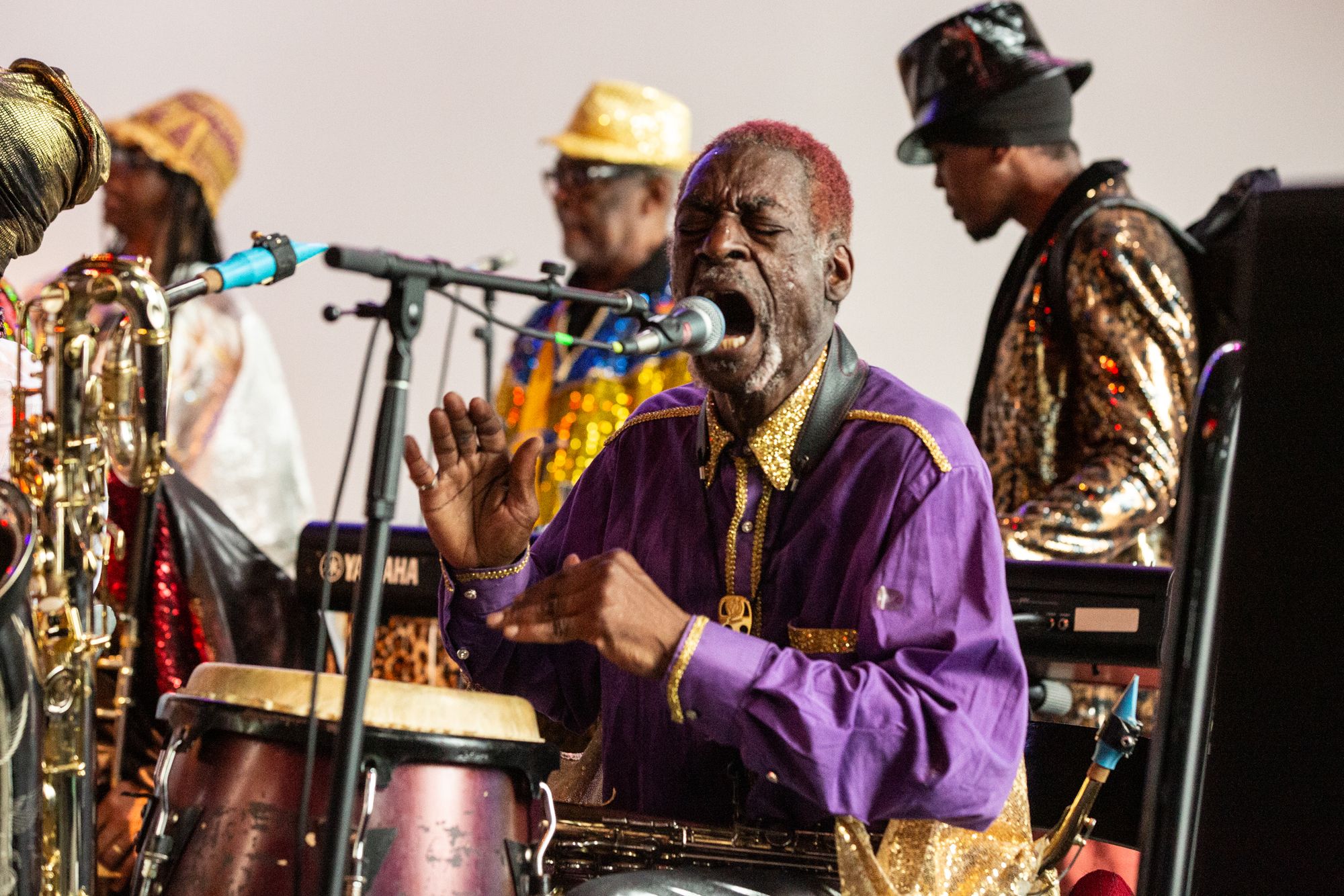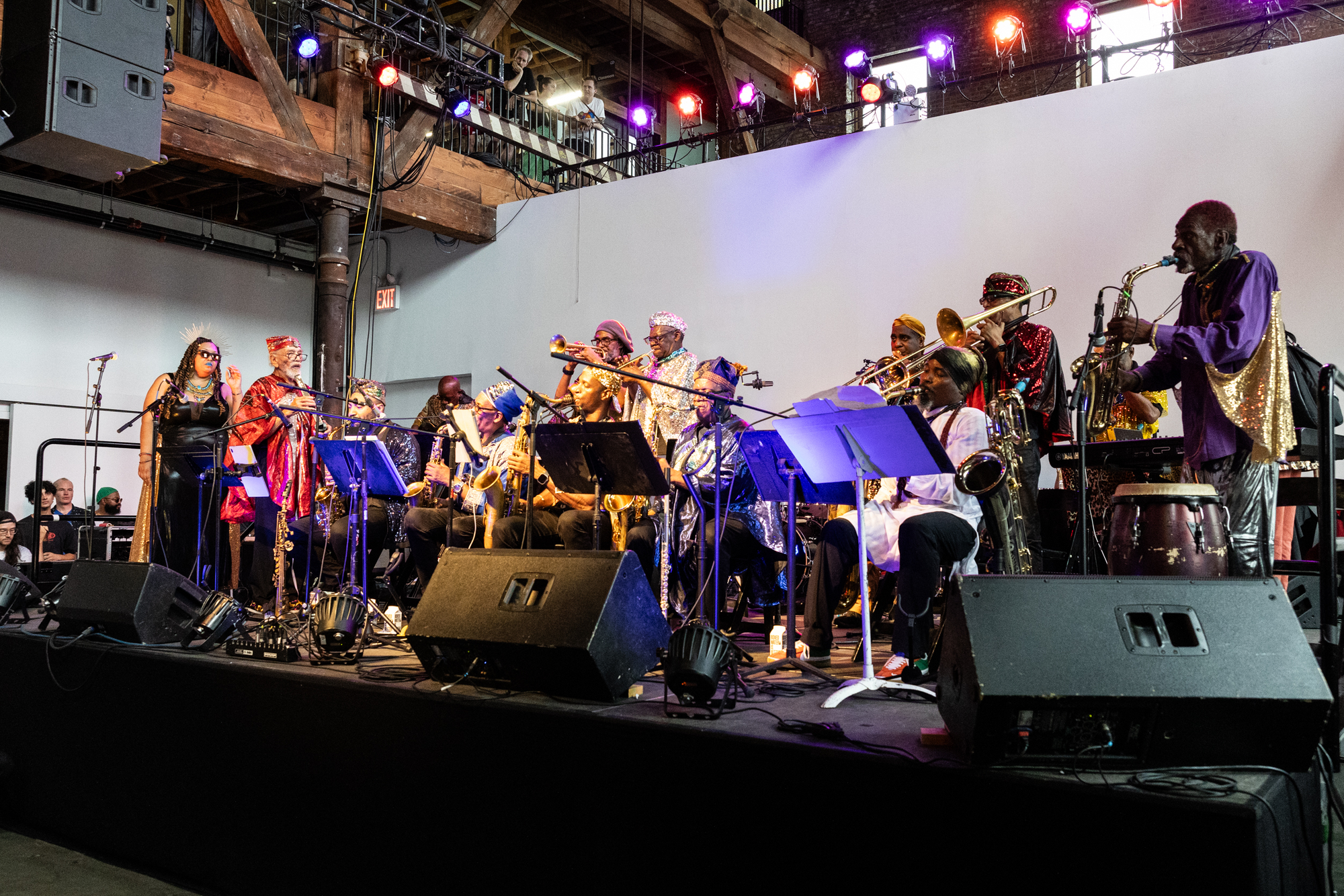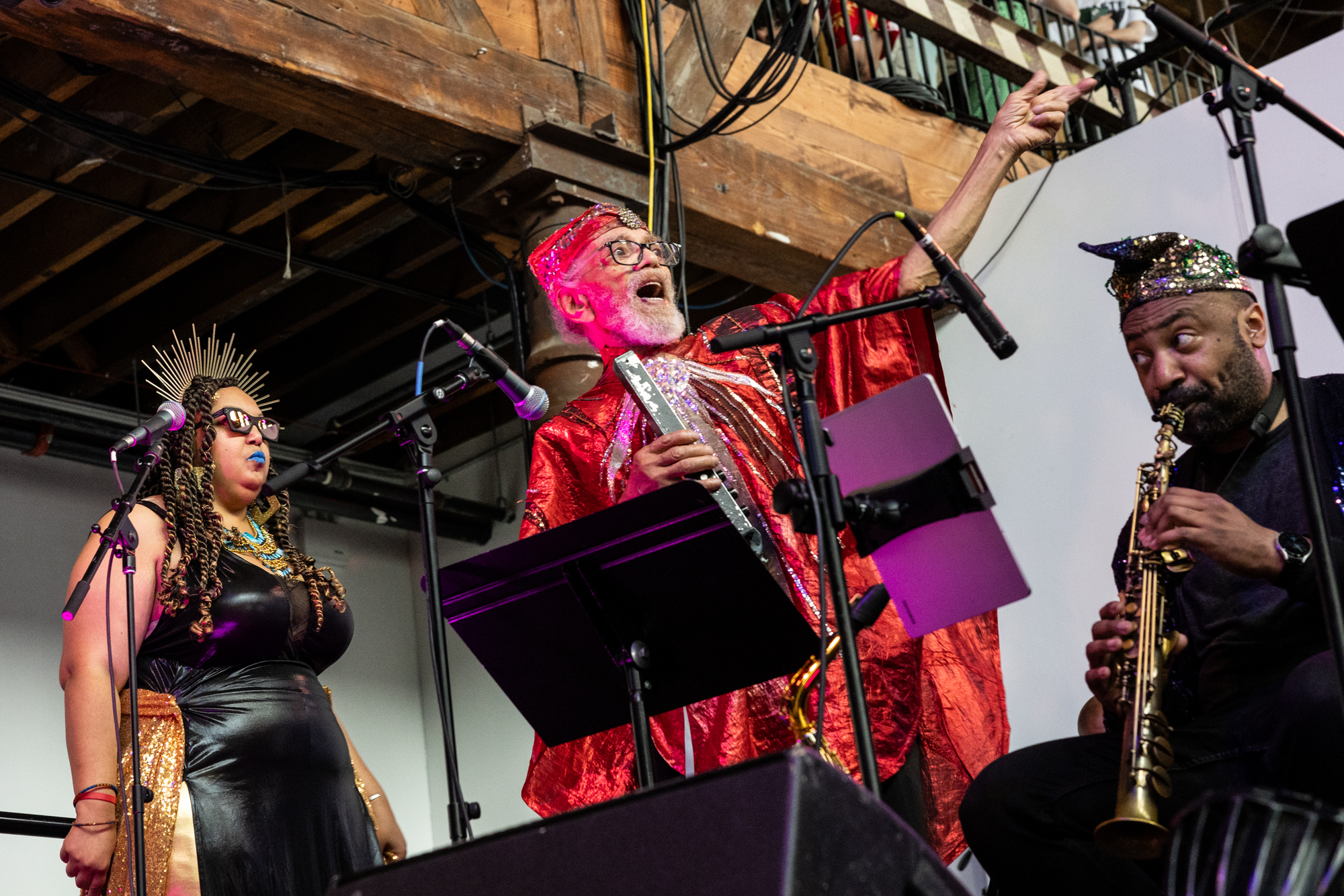Marshall Allen’s Infinite Voyage
Look at Marshall Allen—the slight, bespectacled fireball with gray hair and kind eyes, his arms stretched to the sky. Look at him saunter across the stage, saxophone in mouth, blasting air through the brass. Look at how he’s transformed by the music, and how the audience is transformed by him. See how they marvel at his artistry, his godliness, his age. Marshall is 101 years old, and he still harbors the inferno of years past—when, as an integral member of Sun Ra’s ever-changing Arkestra, his urgent wails bolstered the chaos of the bandleader’s arrangements. And here he stands, albeit a little gingerly, his steps more calculated. That smile still radiates, his heart full.
Hear him now. Hear that squeal, the explosion, the anarchy. Listen to how the wind swaddles the band, how the space opens and lets the soul and the funk come through. While Marshall is what some purists would consider avant-garde, I’ve never seen him that way. He’s what freedom looks like, what it sounds like, what can happen when the confinements of jazz are eschewed for greater experimentation. By definition, Marshall is a jazz musician, but he’s never seemed preoccupied with the genre, nor with any notion of what he’s supposed to be. Whether alongside Sun Ra or at the helm of his own band, Marshall has never seemed to care what you called the music—space jazz, cosmic jazz, or whatever—as long as you felt the liberation emanate from it. Because immortality resides on the other side of this courage, it’s people like Marshall and Sun Ra whose work lives forever, despite the confusion their melodies may cause at first listening. That we’re talking about this music now is the mark of its legacy.
In February, at the age of 100, Marshall released his solo debut album, New Dawn, a stark shift from the vast cutting-edge ethos of his Sun Ra work. Across seven tracks, Marshall and his band—a wide-ranging ensemble featuring several Arkestra mainstays and a standout cameo from Neneh Cherry—opt for straight-ahead serenity over pronounced nonconformity. Abstraction gives way, here, for something more traditional in scope. Where Sun Ra sought liberation through space travel, and believed that Black people would only ever be free on Saturn, New Dawn feels like what we’d play once the mission is completed. It’s the sound of rest and restoration, of finding joy in the quiet moments. It’s also an overdue appreciation for one of the most faithful stewards of Sun Ra’s mission, whose own voice—more subdued than his mentor, yet no less inquisitive—has come to the fore, right on time, at the start of his 11th decade on Earth.
Marshall was born May 25, 1924 in Louisville, Kentucky and started playing clarinet at the age of 10. During World War II, he enlisted in the Army, and while stationed in Paris with the 92nd Infantry (also known as the Buffalo Soldiers), he played alto sax and clarinet in the 17th Division Army Special Service Band. Once the war ended, Marshall stayed in Paris and studied clarinet with Ulysse Delécluse at the renowned Paris Conservatory, then toured with the saxophonist James Moody before returning to the United States in 1951, settling in Chicago. There, after a few years “jamming around” the city, as he told Jazzwise, he met Sun Ra in 1957. He still remembers being transformed by the musician’s Super-Sonic Jazz album. “The stuff they were doing, I’d never heard that before,” he said. “It was far out and [had] different kinds of melodies. So, I went back and asked the guy I bought the record off, ‘Where’s this band? This is a real band!’” The Arkestra rehearsed six blocks away from where Marshall was living at the time. He heard them practicing, came back with his saxophone, and became a regular fixture in rehearsals.
Sun Ra officially brought Marshall into the band in 1958 to join the equally formidable John Gilmore and Pat Patrick in the horn section. Three years later, the Arkestra moved to New York and became part of the city’s underground avant-garde jazz scene. Perhaps influenced by the area’s free-spirited creative mindset, the group’s music got more experimental, and Marshall responded in kind: his playing grew more aggressive and far out, which—along with June Tyson’s emotive vocals and Sun Ra’s high-wire experimentation on piano and synthesizer—further pushed the band’s sound into the deep space they coveted. The Arkestra moved to Philadelphia in 1968, the group’s base until Sun Ra’s passing in 1993. Gilmore took over as bandleader following Sun Ra’s transition. Marshall took it over in 1995 after Gilmore’s death and has led the band ever since. With Marshall at the helm, the Arkestra has maintained the festivity of its founder. When watching them perform, a strong sense of family emerges. The live show is a grand spectacle, complete with flashy robes and ornate headgear, and the music feels big and orchestral. It’s all quite theatrical; walking away, you’re not fully sure what you just saw—but you can’t shake the vibrations you feel.

Sun Ra Arkestra at Pioneer Works, 2023.
Photo: Ellen Qbertplaya
Sun Ra Arkestra at Pioneer Works, 2023.

Sun Ra Arkestra at Pioneer Works, 2023.
Photo: Ellen QbertplayaAs a willing steward of Sun Ra’s legacy, Marshall has maintained the fire of its leader, keeping the music edgy and exploratory while putting his own mark on it. On 2020’s Swirling, the first Sun Ra Arkestra album in 20 years, songs like “Satellites Are Spinning” and “Unmask the Batman” honored the band’s founder with modern flourishes meant to exemplify Marshall’s wide-ranging ear. He peppered these and other tracks with electronic bleeps and bloops that recalled what Sun Ra did with the synthesizer long ago. When heard with 2020s ears and sensibility, Swirling sits alongside the music of Flying Lotus, the noted L.A.-based experimental producer, though Sun Ra and Marshall clearly influenced his sound. Based on his recent affiliations—with the bassist Luke Stewart, the percussionist Carlos Niño, and fellow saxophonist Immanuel Wilkins, among other younger iconoclasts—it’s clear that Marshall is still searching for new inspiration and partners to board the spaceship. Like Marshall, each of these artists create music not fully aligned with any particular genre. Sure, you can call it jazz, but even within jazz’s broad expanse and evolution, it’s tough to classify these purveyors as anything other than radical. Just like Marshall did in the ’60s and beyond, these artists create with audacity, perhaps knowing that the bravery of their art will last generations (assuming they consider such forecasts). They all make the kind of work you’ll talk about years later, after the critics have finally come around to the brilliance that was always there. When I listen to Luke, Carlos and Immanuel, I hear Sun Ra, which means I hear Marshall.
While I appreciate New Dawn and everything Marshall does in the studio, the record to turn to for an indicator of what the artist does on stage, where he’s most at home, is Marshall Allen’s Ghost Horizons Live in Philadelphia, a collection of live sets from the past two years at the venue Solar Myth. For almost 90 minutes, Marshall’s Ghost Horizons ensemble wades through several iterations of jazz, surging over post-bop and swing, drifting through ambient and meditative styles. On “Seductive Fantasy,” for instance, the band leaps into a sharp double-time beat that breaks down and reassembles at the urging of Marshall’s fiery horn blasts, as if prodding the crew to dig deeper and go there. The next song, “Back to You,” is a contemplative drone: Between the sedative bass loop, indiscernible vocals, sporadic sax and glitchy electronics, it almost doesn’t sound like a Marshall Allen cut, at least not in the way we’d expect. His songs usually have a bounce to them; in a good way, “Back to You” feels fresh and progressive, like something from a sci-fi film or heavy steel floating through the cosmos.
Songs like “Stay Lifted” and “Square the Circle” almost border on rock territory; the former a drum-heavy jaunt with echoed trumpet effects, the latter an ascendant house arrangement that could sit alongside Floating Points or golden era Radiohead on a playlist. I also love “Warn Them” when the mood calls for it: Over staggered drums and what sounds like a playing card stuck in bicycle rims, the song lands defiantly. It sounds dark and agitated, writhing in mud and content there. Blame my ear if I’m speaking out of turn, but I can’t remember Marshall or Sun Ra sounding this dour before, even as they lamented nuclear war or pleaded with listeners to wise up before it was too late. “Warn Them” is blues of a different kind: vocally angry, it’s the type of song you play when you need to lean into anguish. Even as we navigate our collective angst, Marshall’s art balances radiance and shadows, his dexterity showing us the way to stay optimistic. I’m taken by his faith in the craft. Because while Marshall Allen isn’t an eye-popping name in mainstream circles, his work and his intent are acclaimed by those making cornerstone music. His legacy is ensured. And yet here he is still trying to create a new world, knowing the voyage is paramount. Whether or not you come along is on you, but Marshall’s taking off. ♦
Subscribe to Broadcast